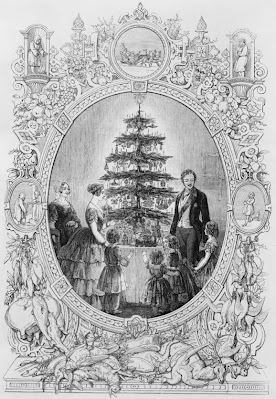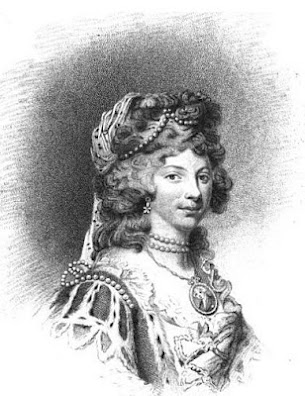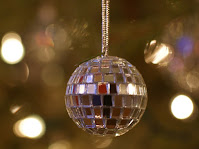 |
| Christmas tree at Windsor Castle from The Illustrated London News Christmas supplement (1848) |
With the approach of Christmas, I decided to do a little research into what a Regency Christmas might have been like. I knew there were Christmas trees in Victorian times, but did they have Christmas trees in the Regency, and if so, were they the same as those we have today?
Queen Charlotte’s Christmas tree 1800
It was back in 1800, more than a decade before the Regency began, that I found the earliest reference to a yew tree being used in Christmas celebrations. The Christmas custom of taking a tree inside your house and decorating it was well-established throughout the German states, and Queen Charlotte, who came from the German duchy of Mecklenburg-Strelitz, introduced this tradition to England.
 |
| Queen Charlotte from Memoirs of her most excellent majesty Sophia-Charlotte, Queen of Great Britain by John Watkins (1819) |
At the beginning of October the royal family left the coast for Windsor, where Her Majesty kept the Christmas-day following in a very pleasing manner. Sixty poor families had a substantial dinner given them; and in the evening the children of the principal families in the neighbourhood were invited to an entertainment at the Lodge. Here, among other amusing objects for the gratification of the juvenile visitors, in the middle of the room stood an immense tub with a yew-tree placed in it, from the branches of which hung bunches of sweetmeats, almonds, and raisins, in papers, fruits, and toys, most tastefully arranged, and the whole illuminated by small wax candles. After the company had walked round and admired the tree, each child obtained a portion of the sweets which it bore, together with a toy, and then all returned home quite delighted.1
It is interesting to note that the tree stood in an “immense tub” in the middle of the room, presumably on the floor; all the other references that I found talk about table-top Christmas trees.
Princess Victoria’s Christmas 1832
Christmas trees continued to be part of the celebrations in the royal household. Queen Victoria’s mother was also German, and the young Princess wrote of Christmas trees in her diary for 24 December 1832:
We then went into the drawing room near the dining room. After Mamma had rung a bell 3 times we went in. There were two large round tables on which were placed two trees hung with lights and sugar ornaments. All the presents being placed round the tree. I had one table for myself and the Conroy family had the other together.2
 |
| The Duchess of Kent, Queen Victoria's mother From La Belle Assemblée (1825) |
However, Christmas trees did not become fashionable in Victorian England until after the Illustrated London News printed an engraving of Queen Victoria, Prince Albert and their family gathered around their Christmas tree at Windsor in 1848. This has led to some people wrongly attributing the introduction of Christmas trees to Prince Albert, whereas, as we have seen, they were already well-established in the Christmas celebrations of the royal family by this time.
 |
| Christmas tree at Windsor Castle from The Illustrated London News Christmas supplement (1848) |
But did anyone outside of the royal family have Christmas trees before their widespread popularity after 1848? It would seem that some people did, especially those with German connections of their own.
Charles Greville, who stayed with the Cowpers at Panshanger for Christmas 1829, described the Christmas celebrations there in his diary. Princess Lieven, one of the patronesses of Almack’s, was also staying there.
Charles Greville, who stayed with the Cowpers at Panshanger for Christmas 1829, described the Christmas celebrations there in his diary. Princess Lieven, one of the patronesses of Almack’s, was also staying there.
On Christmas Day the Princess [Lieven] got up a little fête such as is customary all over Germany. Three trees in great pots were put upon a long table covered with pink linen; each tree was illuminated with three circular tiers of coloured wax candles – blue, green, red, and white. Before each tree was displayed a quantity of toys, gloves, pocket-handkerchiefs, workboxes, books, and various articles – presents made to the owner of the tree. It was very pretty. Here it was only for the children; in Germany the custom extends to persons of all ages.3
 |
| A watercolour box c1820 Victoria & Albert Museum, London |
So, did they have Christmas trees in the Regency? The royal family did, from at least 1800, and some people copied the royal tradition.
This was true of William Cavendish-Bentinck, Duke of Portland, who is recorded as having a Christmas tree at Welbeck Abbey in 1807. His descendant Matthew Ward says: "He picked the habit up from court as he was the Prime Minister at the time."4
Also, other families connected with Germany may have brought the Christmas tree custom to England by that time, quite independent of the royal family.
However, it would appear that Christmas trees as we know them were not popular until after 1848, and that many of the trees that people had were smaller and placed on tables rather than the floor.
This was true of William Cavendish-Bentinck, Duke of Portland, who is recorded as having a Christmas tree at Welbeck Abbey in 1807. His descendant Matthew Ward says: "He picked the habit up from court as he was the Prime Minister at the time."4
Also, other families connected with Germany may have brought the Christmas tree custom to England by that time, quite independent of the royal family.
However, it would appear that Christmas trees as we know them were not popular until after 1848, and that many of the trees that people had were smaller and placed on tables rather than the floor.
Rachel Knowles writes clean/Christian historical romance set in the time of Jane Austen. She has been sharing her research on this blog since 2011. Rachel lives in the beautiful Georgian seaside town of Weymouth, Dorset, on the south coast of England, with her husband, Andrew.
Find out more about Rachel's books and sign up for her newsletter here.If you have enjoyed this blog and want to encourage me and help me to keep making my research freely available, please buy me a virtual cup of coffee by clicking the button below.
Notes
- Watkins, John, Memoirs of her most excellent majesty Sophia-Charlotte, Queen of Great Britain (1819, London).
- Queen Victoria's journals online - December 24 1832.
- Greville, Charles, A journal of the reigns of King George IV and King William IV, edited by Henry Reeve (Longmans, 1874).
- I am indebted to Matthew Ward, a descendant of the Duke of Portland, for this information. The Duke of Portland's papers are held at the University of Nottingham.
Sources used include:
|
Greville, Charles, A journal of the reigns of King George IV and King William IV, edited by Henry Reeve (Longmans, 1874)
Illustrated London News (1848)
Queen Victoria's journals online
Illustrated London News (1848)
Queen Victoria's journals online
Watkins, John, Memoirs of her most excellent majesty Sophia-Charlotte, Queen of Great Britain (1819, London)



Very interesting! I was among the people who believed that Christmas trees were introduced by Prince Albert. Thanks for correcting the misperception.
ReplyDeleteGlad to help. It is a very easy mistake to make as Christmas trees did not become widely popular until after his much publicised tree at Windsor in 1848.
DeleteLove these tidbits of lore about regency times!
DeleteI'm so interested in this. Though I have the feeling you're right.
ReplyDeleteThank you for this Rachel! Very helpful information.
ReplyDeleteDid you find out when the custom of taking the tree and decorations down on twelfth night originated, presumably it would have been around the same time, but you never know with the English, we're a perverse mob
ReplyDeleteSorry, no. That didn't crop up in my research. It would be interesting to know though, wouldn't it?
DeleteThat tradition is much, much older, and might even go back to pagan times. In the Middle Ages and the Renaissance it was considered bad luck to leave the seasonal green boughs, holly, etc up past 12th Night. They had to be taken down and burnt. So I'm guessing that the same became true of the trees and ornaments.
DeleteI love the idea of a giant yew tree in the house. Let's hear it for Queen Charlotte! This is my first time to your site- thanks, Rachel!
ReplyDeleteHi Bess - glad you found my blog :)
DeleteI think it's interesting that Queen Charlotte's tree of 1800 is talked about as being in a huge tub - presumably on the floor, whereas the others refer to trees on table tops.
Excellent! Thanks for sharing this.
ReplyDeleteThanks Vikki :)
DeleteIn German-speaking lands, the origin of the Christmas tree is pagan, as the Germanic tribes worshipped trees (they believed each tree had its own individual spirit that dwelled within the tree). This is one reason the Puritans frowned not only on Christmas trees, but all Christmas customs which they considered "popish." Ironic, because it was originally pagan, not Catholic. Regency Anglicans would not have liked either the association with the pagan or with the Catholics. But when the royals introduced the custom, it became what we would call a fad to have a Christmas tree!
ReplyDeleteIt is amazing what people will accept when it becomes fashionable!
DeleteDecorating with evergreen boughs, holly, etc (also obviously pagan) was resumed after the Restoration, however, so taking the step toward adding Christmas trees wasn't such a huge one.
Delete